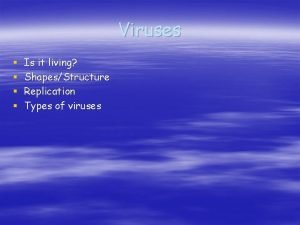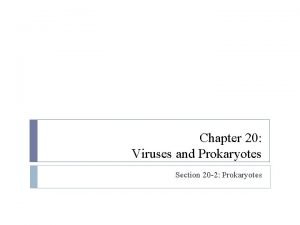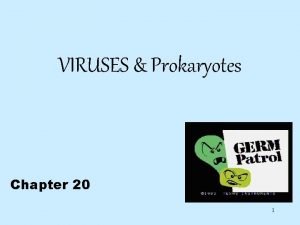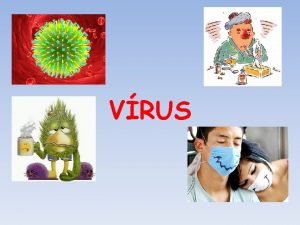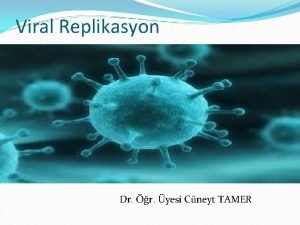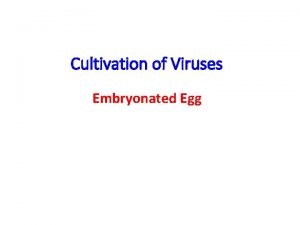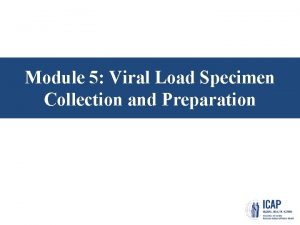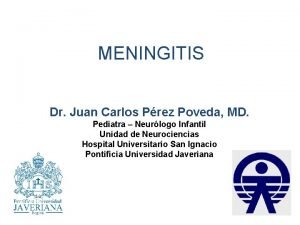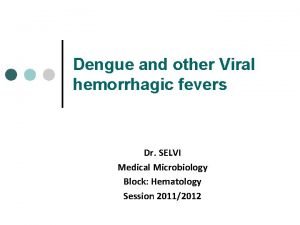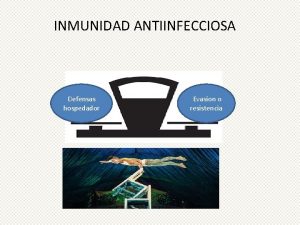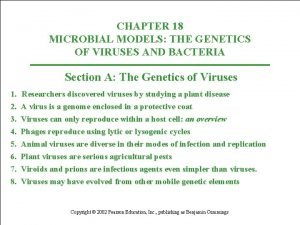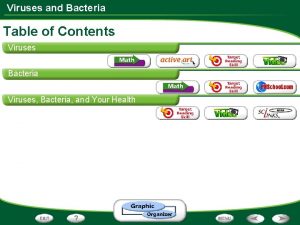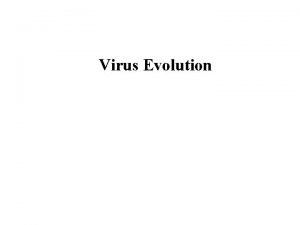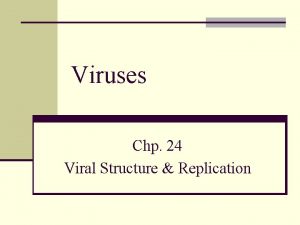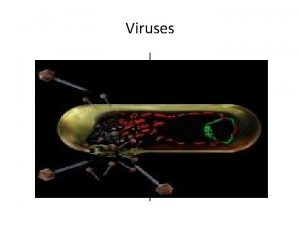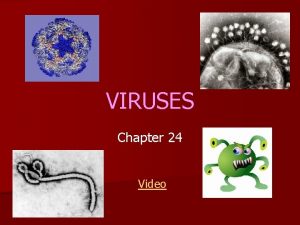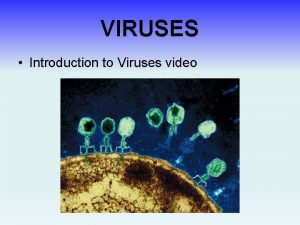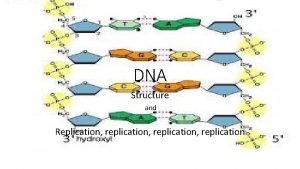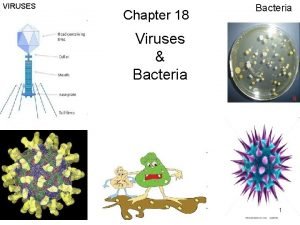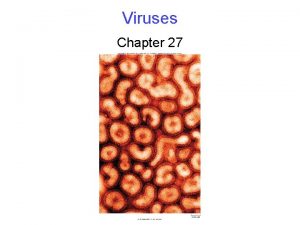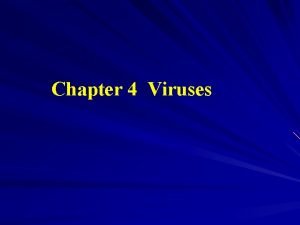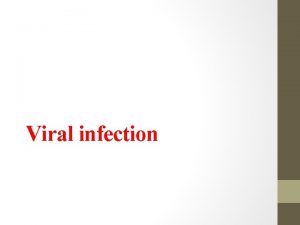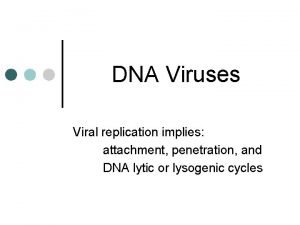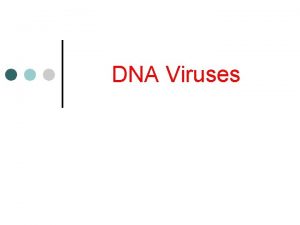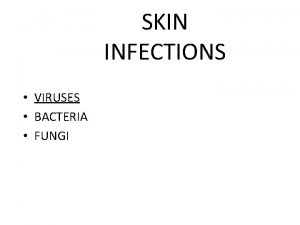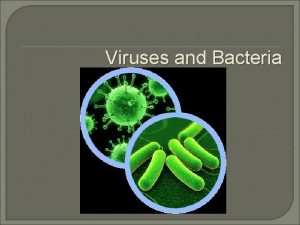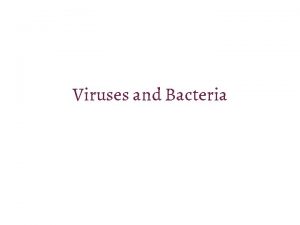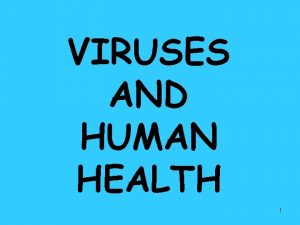VIRUSES Chapter 24 Video VIRAL STRUCTURE AND REPLICATION































- Slides: 31

VIRUSES Chapter 24 Video

VIRAL STRUCTURE AND REPLICATION Section 24. 1

Discovering Viruses: n Late 1800’s – Something very small is causing diseases! n 1935 – It is not made of cells (living things). TMV Polio HIV

What is a virus? n. A nonliving particle composed of a nucleic acid and a protein coat. n Study of viruses = virology

Why do we study them? n Cause disease in living organisms n Useful tools for genetic research

Are viruses living? The Characteristic of life: growth homeostasis metabolism organization cells reproduction n Viral characteristics: NO NO NO YES NO within host cell

Common Diseases Caused by Viruses n AIDS n Influenza n Chickenpox n Rabies n Polio n Mumps n Colds

Viral Structure n n All viruses have: 1. Nucleic acid: (DNA or RNA) 2. Capsid: protein coat Some viruses have: 1. Glycoprotein projections: signals 2. Envelope: Bilipid membrane surrounding the capsid. § Can fit “lock-and-key” with receptors on host cell.

HIV

Grouping viruses based upon… SHAPE AND STRUCTURE: n Envelope present or not? n DNA or RNA? n Single stranded or double stranded? n How does it affect a human? Rabies Hepatitus Herpes

Viral Size & Shape n Size: – 20 to 250 nm – Cannot be seen by a light microscope n Shape: – Determined by the genome (DNA) or capsid

Some shapes: H 1 N 1 or influenza Video

Viral Replication: Obligate Intracellular Parasites (huh? )

Viral Replication in Eukaryotes n DNA viruses: – DNA m. RNA proteins – Provirus: inserted viral DNA into host cell n RNA viruses: – m. RNA protein n Retroviruses: – RNA DNA m. RNA protein – Reverse transcriptase: enzyme – Example: HIV

Viral Replication in Prokaryotes n Bacteriophage: virus that infects bacteria n Helped scientists discover how viruses replicated n Two replication cycles – Lytic cycle: virulent – Lysogenic cycle: temperate

L Y T I C C Y C L E Animation

L Y S O G E N I C C Y C L E Animation

Origin of Viruses n Early viruses evolved from early cells n Viruses mutate quickly and frequently – Thus they evolve quickly – New strains formed this way

Viral Disease Section 24. 2 Flu Video

Vectors n An intermediate host that transfers pathogens from one organism to another n Examples: – – – Humans Animals mosquitoes Fleas ticks

Chicken Pox & Shingles n Virus: varicella-zoster herpesvirus n Symptoms: rash & fever n Replication: Multiplies in lungs and uses blood network to reach skin n Transmission: direct contact with skin rash

Viral Hepatitis n Virus: Hepatitis A, B, C, D, E n Symptoms: – Fever, nausea, jaundice, liver failure n Transmission: – Sexual contact (B, C, D) – Fecal matter in food & water (A, E)

AIDS n Virus: HIV – retrovirus Transmission: through bodily tissues and fluids n Symptoms: weakened immune system n n Treatment: Drugs target reverse transcriptase OR stop new capsids from forming (protease inhibitors).


Viruses and Cancer n Cancer: when cells divide at an uncontrolled rate and form a tumor n Oncogenes: viral genes that cause cancer n Examples: – HPV cervical cancer – Hepatitis B liver cancer – Epstein-barr lymphoma

Emerging Viruses n New viruses are being discovered every year as humans alter ecosystems n Examples: – – HIV Ebola SARS West Nile

Preventions and Treatments 1. Vaccinations: to prevent disease q Solution containing harmless version of virus q Causes an immune response in the body 2. Vector Control: n Wildlife population control 3. Drug Therapy: n Interfere with viral nucleic acid

2 types of Vaccines: Inactivated (killed)- virus particles 2. Attenuated (live)- weakened form of the virus 1. – Provide greater protection from disease • Has lead to the eradication of some diseases ex) smallpox • Common vaccines: measles, mumps, rubella, polio, hepatitis A & B, chickenpox

How to protect yourself and others… 1. Wash your hands! 2. Don’t share tools (cups, toothbrushes) 3. Use protection when transmitting bodily fluids 4. Don’t become someone’s “Blood brother” 5. Avoid being bitten by animal 6. Cover your mouth when sneezing

Non-virus Disease Causers: Viroids – a short singular strand of RNA § smallest known particle to cause disease § infects mostly plants Prions - protein particles without a genome § mad cow disease

Practice Graphing Problem
 Section 24-1 viral structure and replication
Section 24-1 viral structure and replication Lytic cycle animation
Lytic cycle animation Lysogenic cycle animation
Lysogenic cycle animation Replication of viruses
Replication of viruses Viruses video
Viruses video Bioflix activity dna replication lagging strand synthesis
Bioflix activity dna replication lagging strand synthesis Egrette - chapter 21
Egrette - chapter 21 Chapter 20 viruses and prokaryotes
Chapter 20 viruses and prokaryotes Bacteria and viruses chapter 7 lesson 1 answer key
Bacteria and viruses chapter 7 lesson 1 answer key Chapter 20 viruses and prokaryotes
Chapter 20 viruses and prokaryotes Chapter 18 section 2 viruses and prions
Chapter 18 section 2 viruses and prions Haploid vs diploid
Haploid vs diploid Multiple choice questions on dna structure and replication
Multiple choice questions on dna structure and replication Dna structure and replication
Dna structure and replication Section 19-3 diseases caused by bacteria and viruses
Section 19-3 diseases caused by bacteria and viruses Section 1 studying viruses and prokaryotes
Section 1 studying viruses and prokaryotes Aerochamber definition
Aerochamber definition Vrus
Vrus Inklüzyon cisimcikleri
Inklüzyon cisimcikleri Viral inoculation in embryonated egg
Viral inoculation in embryonated egg Viral inoculation in embryonated egg
Viral inoculation in embryonated egg Viral inoculation in embryonated egg
Viral inoculation in embryonated egg Spasmodic croup
Spasmodic croup Dea anggraini viral
Dea anggraini viral Decapsidação
Decapsidação Hemolyzed serum sample
Hemolyzed serum sample Meningitis viral antibiótico
Meningitis viral antibiótico Causes of viral hemorrhagic fever
Causes of viral hemorrhagic fever Ciclo viral
Ciclo viral Viral infection
Viral infection Viral
Viral Viral recombination
Viral recombination



